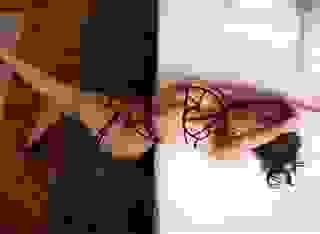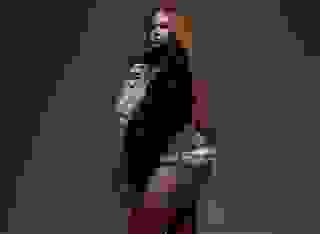Note: You can change font size, font face, and turn on dark mode by clicking the "A" icon tab in the Story Info Box.
You can temporarily switch back to a Classic Literotica® experience during our ongoing public Beta testing. Please consider leaving feedback on issues you experience or suggest improvements.
Click hereOf the selected captains, only the first two pursued the assignment with gusto; their ships went into action early on a test basis before the internal/external docking question was solved.
They're being constructed in Basin Number 114-IV. They're officially known as the Kenning class; they were supposed to be named for kennings, but that turned into mythical swords.
- K001: USS Lavatine (from Laevateinn, crafted by Loki), Cdr (P) Skeffen bar-Murphy. A prototype with external fighter deployment, currently being retrofitted (uparmored).
- K002: USS Angradal (from Angrvadall, "Stream of Anguish") Cdr Chelle Leeuwen. A prototype with internal fighter deployment.
- K003: USS Naegling ("The Nail," Beowulf's sword), Cdr Elon Borgia. Sounds lazy, but ain't. Previously supported P/E ops in the Spirals.
- K004: USS Skofning (from Skofnung, Hrolf Kraki's sword, containing the spirits of 12 berserkers), Cdr Wazman Daveen (short, fierce, with a beard)
- K005: USS Tirving (from Tyrfing, which kills its owners), Cdr (a) Pixy Pfeiffer. This is the last K-ship without direct GP Service loading.
- K006: USS Durlindana (It, Durendal), Cdr Juancho Peet . Skinny. First ship to be attacked from within the Vag on the nightside of Helvidius IX. XO Cdr (a) Evie Lindon. Under repairs.
- K007: USS Dansleff (from Dainsleiff, "Dain's legacy," King Hogni's sword), LCdr
- K008: USS Fragarach ("Retaliator," an Irish sword that commands the wind), newly commissioned. LCdr (P) Strollsung Valladock
A Brief History of Organic Armor
By S. Moogterman
Thrust-to weight ratio has been a major limiting factor since space travel's earliest ages, and nowhere is that better represented in the modern Fleet than by the difficulty inherent in armoring ships whose duties take them into enemy fire at a volume beyond the norm.
It was discovered centuries ago that merely thickening the armor, apart from its unfavorable impact on spacecraft performance, was not an effective long-term solution: Fleet added armor, its enemies developed new weapons systems and tactics to defeat this, so Fleet added more armor, and so on and so forth. This is clearly not a sustainable system.
The development and use of negative-energy shielding (NES), a widespread and effective (if wretchedly expensive) way to prevent spacecraft damage, solved much of the problem. However, given the energy demands of constant shielding under endless bombardment, to say nothing of the number of generators needed for full coverage of most warships, two things limit an NES-equipped vessel expected to be subject to severe barrage:
- The vessel must be able to maintain a constant and limitless supply of energy, and
- The NES system needs a backup, like any other critical ship system.
Problem 1 above is obviously infeasible; Problem 2 merely leads back to the initial dilemma. Most ships can get away with reactive skirting as a backup, but this is unsuitable for sustained bombardment.
Worse, a vessel designed to take consistent enemy fire needs equally consistent repair of what armor she does carry, limiting (or eliminating) her combat effectiveness in the recovery period. Such repairs also degrade the effectiveness of solid armor over time, in addition to the other weaknesses.
Hence? Organic armor.
The organic armor system (OAS) is alive. It generally takes the form of a smooth covering that surrounds a vessel, and it is essentially 100% effective against directed energy weapons. Its effectiveness against solids depends on its thickness and on the kinetic energy carried by the projectile, but the armor benefits in that case from being self-repairing. Kept adequately fed, and with the right mindset, OAS reliably protects hulling, especially in conjunction with NES.
Key to the degree of protection OAS is able to provide is the relationship between the armor and the ship's captain and crew. While OAS is almost always prepared to be kindly disposed in this regard, captains who overuse electrical herding techniques or who, in the armor's opinion, prevent it from protecting vital ship areas, can make the armor sulky. Well-trained armor is capable of fairly rapid deployment over unprotected hull areas, or of self-reinforcement if it judges threats to be imminent.
Of by far the greatest significance in terms of utility to Fleet, however, is the OAS' ability to heal in the aftermath of harsh orbital engagements. This is best achieved in direct UV starlight, unfiltered; the magnitude of the star (or stars) helps determine the speed of regeneration. Wise captains place recovering ships in direct nearby starlight where possible, and take occasional feeding breaks while in transit (generally, every ten square meters of hulling requires five minutes of direct UV exposure at standard solar-orbital ranges).
OAS does not tolerate atmosphere well at all, in that there is no direct UV light to keep it nourished. It also does not like gravity; it functions best when it can freely move around, and is adapted for use in zero-G.
Guiding Notes, Placer/Extraction Command Conference
S. bar-Murphy and C. Leeuwen
Introduction and Accepted Recommendations
These notes cover the prototype deployments of K001 and K002 during joint operations against Cathos Vremein forces on C-Cassavetes Moons 1, 3, and 5 during the past month. K001 struck Moon 3, then moved to assist K002 at Moon 5 following K002's more successful operations at Moon 1. Overall findings validate the K-vessel concept while ascertaining that K-ships operate best with interior stowage and deployment of shuttles and fighter craft.
We are pleased that the Joint Cargo Modules (JCMs) of ships K003 through K008 be constructed accordingly, along with immediate armor retrofitting of K001's JCM prior to further operational deployment.
We remain encouraged that the assignment of tender craft to each K-ship has also been approved by Admiral Jominus, with tentative endorsement by Fleet Central. Our prototypical experiences show that the assault phase of placer operations, in particular, entails a heavy expenditure of munitions and a strong possibility of armor damage. Tenders do not prevent this, but they do limit the amount of time during which the K-ship is redlined following a given placer operation.
General Tactical Concept
As originally mooted by Cdr bar-Murphy and approved by Admiral Jominus and General Percy, the general lines along which the K-ships are designed aims to provide the Army with a stable, secure, protective environment in which they can plan and prepare landings against defended planets. Subsequently, the ships will provide high-impact preparatory fires in accordance with the Ground Tactical Plan (GTP), and will become a stable platform from which the Army can launch its operations, as well as a refuge to which they can return on either a planned or retrograde basis.
The prototype deployment showed that K-ship design is adequate to the tasks envisioned, subject to the recommendations we endorse.
Recommended Deployment Sequence
Approach Phase
Surprise matters; the enemy's ground counterattack is going to happen, and the later he begins stirring, the better. Ideally, the approach places the K-ship precisely above the target area directly out of lightspace, executing a +3 deceleration burn to within +/- 10% of planned placer altitude. This calls for a precise burn, but also for excellent navigation that accounts for planetary rotation, gravitational field, orbital debris, satellites, and axial tilt; as such, most missions will require one or more doglegs to reach the precise placer zone.
Once pinned above the objective, the K-ship ideally does not move for the duration of the placer operation.
1. Local Reconnaissance
The ship arrives in orbit above the target area, previously identified. Sensor scans confirm or deny prior intelligence to the extent possible.
A platoon or company recon element descends immediately, with the Fighter Chief as security so that s/he can finalize the fighter escort plan.
Once the recon pinpoints the objective area and the K-ship conducts necessary maneuvers to get there, they establish an LZ and the K-ship captain, serving as Space Officer Commanding (SOC), gives the final order for the attack. At this point, the SOC's responsibilities shift: the vessel's role is to remain pinned at geosynchronous orbit until released by the Army, so spaceborne defense becomes the SOC's primary focus.
2. Suppressive Bombardment
The ship centers its main battery over the pinpointed LZ. A fighter section deploys as local security and OP, interdicting enemy near-orbit defenses. All weapons systems are pre-registered for a destructive cone (CoD) of varying sizes, based on the ship's altitude.
As firing commences at full-scale "assault rate," the recon element provides impact-zone corrections, perimeter refinement, and target intelligence. The senior officer present determines when suppression is sufficient.
Subsequent bombardment continues at a decreased "sustainment rate."
3. Placer Operation
Once adequate suppression occurs the Ground Officer Commanding (GOC), normally the commander of the embarked battalion, orders the shuttles out. They descend within the CoD, escorted by a fighter section.
Placing occurs with the fighters providing local CAS. Once the GOC determines a secured spacehead has been established, this fighter section returns to orbit to join in the interdiction efforts. It is the SOC's direct responsibility to ensure the CoD does not impact the returning fighters.
The Ground Tactical Plan (GTP) commences IAW battalion SOP.
4. Support
The SOC's focus now shifts to overall support of the GTP. S/he descends to Extraction altitude (enemy activity permitting) and sustains counterattacks from the planetary defenses while the GTP proceeds.
The targeting officer, in conjunction with the Ground Tactical Liaison (GTL; often the battalion XO or the HHC commander), continues planning and providing spaceborne supporting fires as needed by the GOC.
The SOC directs supporting capital spacecraft in defense of the K-ship.
5. Extraction Operation
Withdrawals occur either on a planned basis, or under duress. Planned withdrawals can proceed IAW whatever criteria have been previously established between the GOC and the SOC.
Unplanned withdrawals, such as K002's abandonment of the initial LZ on Moon 1, require the ship to descend to unsafe altitude in order to shorten the extraction.
The SOC extends the docking spar toward the surface.
The most challenging part of this operation (atmosphere dependent) is the ascent into orbit with all shuttles and transports at soft-dock on the spar, and with some inside blue point and others out. Care must be taken with reembarkation of all personnel once outside the planetary defenses.
Immediate placer activity is, however, possible directly from the spar following a short displacement within atmosphere. It is suggested that the GOC take personal control of placer sequencing in this case. Fires should be limited, as low K-ship altitude is likely to render suppressive fires intense, with an abnormally small perimeter.
Overall Further Recommendations:
- Concerns noted include the punishment to which the ships are subjected during execution of the GTP, especially during the assault phase. Further training with the self-regenerating armor is needed, along with proofing of that armor against Flasbard munitions. The effort to assign tenders to each K-ship is already underway, and can help with this.
- A recommendation involves the future addition of one more organic fighter section to reduce the strain on the section used while escorting the placer forces dirtside; these pilots must return to orbit at once and engage in immediate interception, which places a strain on their mission payloads while also overtaxing the interdiction section during the placer phase.
- It is essential that captains of supporting warships understand that the GOC's guidance and directions are to be taken as orders, despite any potential imbalance in rank. Optimally, the Commodore or Admiral in operational charge of those warships committed to the support of the Army operation would post him or herself aboard the K-ship on a temporary basis, such that the GOC's directives can be transmitted to supporting captains with minimal disruption.
- Thought should be given to added doctrine that can support covert operations with K-ships.
- Discussions have arisen WRT use of the ship itself as a ground-effect engagement platform. We suggest that use of the CoD oriented horizontally, while in atmosphere, would be irresponsibly and unpredictably unsafe. Further, the identification of a suitably large hard-surface landing field is problematic: to prevent undue energy expenditure on ascent, accompanied by excessive cratering, the surface would need to be quantifiably hard to a depth of at least 14 meters.
- Develop SOPs for the tactical employment of tender ships. These include the need to ensure rapid resupply for follow-on operations, with the goal that a second full assault-rate CoD can begin within five hours of the completion of the previous one. Further consideration should also be given to the location and activities assigned to the tenders during combat operations.
* * *
Excerpt from Federal Myths and Institutions: A Basic Introduction by EA Masprach
[note: Masprach used "planet" loosely, with an understanding that in discussions of government, GDP, or other similar measures, "planet" or "planetary" was meant to refer to any primary governing tier, whether the polity involved was an actual planet, a dwarf, a moon, a star system, a galaxy, or even a region]
By the time first contact was made with the Cathos Vremein, the Federated Planets had reached their most mature form. Gone were the days of the Federated State, with its tentative experiments in universal government. What replaced the ideals of the State was a web of intergalactic relationships most typically characterized by several things:
- adherence to the Federated Constitution
- the demands of the ongoing wars against the Flasbard Confederacy and the Cathos Vremein
- a strong belief in planetary kapu (customs and traditions)
What developed was a form of quasi-government that has most recently been described (Quabbin, pg 332) as a form of distributed vassalage, the basic form of which left planets (or in some cases galaxies) to form their own cultures without regulation so long as they met their obligations in terms of Federal service.
In return, the Federated Planets promised protection from invasion as well as a rudimentary form of inter-planet conflict resolution (though, in practice, the Federal bureaucracy tended to leave such conflicts in the hands of their respective planets).
The Federated Constitution
The Constitution encompassed customs, laws, regulations, and precedent in a pan-galactic context. Its applicability was determined by the Federated Council, which theoretically included representation from every planet. Of note, however, is the fact that the Council was not a deliberative body, like a legislature: it was a determinative body, like a court.
As problems and questions arose, the Council met to determine what the Constitution said about those problems and questions. They determined whatever course of action the Constitution prescribed, then moved on to the next set of disputes.
The issue lay with enforcement. As long as the various planets and other entities respected the Constitution, they generally abided by the Council's interpretation and obeyed their course of action. In rare cases, planets chose to disobey Council Orders, at which point the Constitution determined what happened next (see "ejection," below).
By the start of the conflict with the Cathos Vremein, the Federated bureaucracy consisted of the following institutions:
- The Federated Council. The council consisted of representation from all Federated polities on a voluntary basis. Many planets or systems chose not to send a representative, or elected to rely on a proxy lobbyist. A handful of planets live under DFC, and are administered by the Council (usually for classified and/or military purposes).
- The Federated Army. The Army conducted combat operations on any and all natural gravitational surfaces. Its remit did not include combat in self-sustaining manmade environments, such as space stations.
- Fleet. The function of Fleet was to conduct interstellar combat using its capital ships and its Stellar Marines. In addition, it assisted the Diplomatic Service in its activities. It also managed the Fleet Academies.
- The Federated Institute of Medicine. The main purposes of the Institute were to conduct research and development for universal benefit, and to manage the increasingly complex Cloning Service.
- The Diplomatic Nuncio. This was a roving group of couriers, legates, diplomats, ambassadors, and investigators that delivered Council Orders and attempted to see to their enforcement. The Service also managed espionage and propaganda, and maintained the Federated Register and the Census Bureau.
The Wars
Quite when the intergalactic wars against the Flasbards and the Cathos Vremein became the Federated State's main activity is a matter for historians, but the fact was that the vast majority of the Council's energy (and money) existed to support the ongoing war effort.
Distributed Vassalage required a specific levy from each planet, which each planetary government could raise as they wished. Planets failing to meet their quota assumed a greater tax assessment; if they could do neither, they could be removed from the Federation through a process called EJECTION. This came with public notice through the Nuncio that the planet now lay outside Federated protection.
In addition to these levies for off-planet War service, planets maintained a semi-official Militsia designed to be used in-system. There were circumstances under which the Militsia could be pressed into off-planet service, though that required the consent of the planetary government.
Planets maintained their support for the Wars through whatever propaganda means their governments dictated, but their reasons were generally easy to understand: planets received Federated war-related infrastructure in the form of shipyards, bases, hospitals, clone farms, prisons, etc, while also giving governments the ability to offer steady Federated employment to their more restless citizens, who might otherwise remain at home to cause problems.
Kapu
Planets, from the start of their Pioneer period and continuing through Settlement, had always received very broad discretion in determining their own customs, traditions, religious practices, laws, and institutions. Diversity was always encouraged as a way of capitalizing on existing environments, maintaining economic flexibility, and developing a unique planetary history and culture. Thus, in addition to the genetic diversity built into the corporate Terraformer-Pioneer-Settler-Colony cycle, newly occupied planets helped human survival on cultural as well as biological levels.
The following are some Planetary Federated Census statistics from the time of Cathos Vremein contact (n = 12,544 planets + 30,226 other polities).
Religion: 22% monotheistic, 9% polytheistic, 30% spacecult (variably defined), 28% agnostic, 10% animist.







